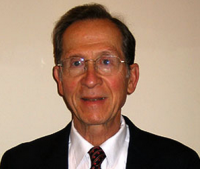










Charles H. Henry was born in Chicago, Illinois, USA, on May 6, 1937. He received an MS. degree in physics in 1959 from the University of Chicago, and a PhD degree in physics in 1965 from the University of Illinois, under the direction of Charlie Slichter. In March, 2008, he was featured in an article in the Physics Illinois News,a publication of the Physics Department of the University of Illinois.
His Research Career
Charles H. Henry’s work in semiconductor physics research in optoelectronics over 33 years at Bell Laboratories in Murray Hill, New Jersey, is noteworthy both for its innovation and insight as well as for its breadth. His accomplishments bridge the gap between physics and engineering and demonstrate a rare mastery of both theory and experiment.
Henry spent his entire career at Bell Labs, working on LEDs, semiconductor lasers, and integrated optical circuits. In his early studies of Raman scattering and photoluminescence, Henry was the first to experimentally observe polaritons. An important early result was identifying the source of the red light emission in GaP LEDs, an exciton bound to a nearest neighbor donoracceptor pair involving the deep donor Oxygen.
He went on to studies of catastrophic damage, mode partition noise, spontaneous emission noise, and quantum noise in photonics. As Head of the Semiconductor Electronics Research Department in the early 1970’s, Henry suddenly realized that if the light-emitting active layer of a semiconductor laser were made extremely thin, the optical absorption edge would be transformed by quantum effects from a smoothly increasing function into a series of steps. These thin laser structures came to be called quantum wells. Henry realized that this modiied laser structure would result in a semiconductor laser with improved performance, allowing very high quantum efficiencies. He also realized that the laser wavelength could be changed merely by changing the thickness of the thin quantum well layers. He received a patent for this invention, which came to be called the quantum well laser.
Henry is also well-known for his work introducing M. Lax’s alpha parameter into semiconductor laser physics, which Henry used to explain the observed wide linewidth of these lasers. He pointed out the importance of a phase noise contribution not present in the original Schawlow-Townes theory. His paper on this topic is frequently cited due to the importance of this parameter (now known as the Henry linewidth enhancement factor) in determining the line broadening and frequency modulation of semiconductor lasers.
An important aspect of Henry’s work in the late 1980s was his role in developing a new way of making integrated optical circuits, which came to be known as silicon optical bench waveguide technology. This technology came to be widely used in fiber optic telecommunications.
Retired from Bell Labs as a Distinguished Member of Technical Staff in 1997, Henry has 133 published papers and 27 patents. He is a fellow of the American Physical Society, the IEEE, and the American Association for the Advancement of Science. His other honors include the Alumni Award for Distinguished Service from the College of Engineering, the OSA Charles H. Townes Award, the IEEE Jack A. Morton Award, and the AIP Industrial Applications of Physics Prize.